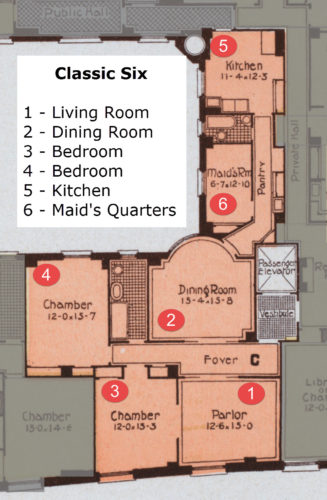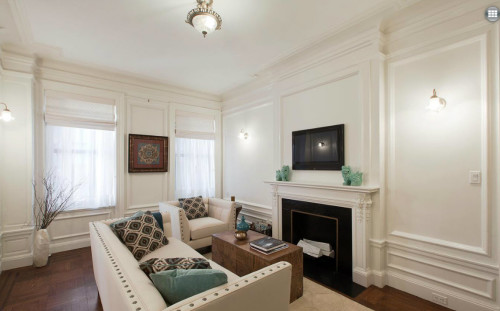Half Classic Six
The Pursuit of Happiness in Manhattan
First, What is a Classic Six?

This example of a classic six from the Peter Stuyvesant (1912) on Riverside Drive shows how public and private areas were kept separated, while the help was relegated to a service entrance off of the kitchen.
Allow me to first define what a Classic Six is… Essentially it is a two bedroom apartment, but it is not what we typically think of as a two bedroom apartment in our modern world. According to Wikipedia: “A Classic Six is a six-room apartment floor plan found in buildings built in New York City prior to 1940. It consists of a formal dining room, a living room, a kitchen, two bedrooms, a smaller bedroom sometimes referred to as a maid’s room, and one or two bathrooms. A maid’s room is located away from other bedrooms, almost always off the kitchen to allow maids of the past easy access. A typical maid’s room also has a small bathroom attached to it.” See also: Classic Seven, Classic Eight, Classic Nine, etc…
At the turn of the 20th century, single family townhouses were beginning to climb in price making it more difficult for families to afford all that went into owning a single family townhouse. Developers picked up on this and began building what were essentially luxury homes in the sky to provide a space for families which felt like a single family home instead of just an apartment. The majority of these high-class homes were constructed on the Upper West Side of Manhattan from the low 60’s all the way up to Columbia University at 116th Street. They were also popular (but less prevalent) on the Upper East Side, in Hamilton Heights, Washington Heights as well as in Midtown (where most have long been torn down for office development).
The classic six became the ubiquitous standard by which which many middle class families strove to establish their status within New York Society. In 1910, a classic six would typically rent for a monthly rate of about $90 to $110 (this adjusted for inflation equals about $2,250-$2,750 in 2016 dollars, but you would be hard pressed to to rent one for less than $6,000 in today’s world) for which you would get about 1,400 square feet of very comfortable living space with the latest in modern technologies of the era. While the wealthier and larger families would rent classic sevens (three bedroom), eights (three bedroom with library), nines and larger (often exceeding 2,500 sq ft), it was the classic six which became the apartment defining life for the middle classes in New York City in that time.

This is a living room in another building designed by the same architects as ours and built less than a year later. The details on the walls and ceilings are identical to what was once in our apartment and typical of classic apartments of the era.
These classic apartments were sprawling places with graciously sized rooms outfitted to look just like the interiors of the town houses they were emulating. They usually had ceilings nearly ten feet high with custom plaster molding details, inlaid floors of oak and mahogany, over-sized moldings and doors, and paneled dining rooms with beamed ceilings. This was also the era when decorative fireplaces began to appear for the first time (in keeping with the illusion that families were living in town houses). These apartments also featured modern kitchens with butler pantries and service entrances for deliveries, and large (for the time) fully outfitted bathrooms with corner tub-showers. These homes also provided for live in staff with separate maids quarters with their own private (small) bathrooms. The buildings often had a dormitory style bunk house on the roof to house the “man servants”, usually porters and hall boys provided by the landlord, and shared by the entire building for doing such things as carrying packages, or securing transportation.
The boom years of construction for classic sixes (and classic sevens, eights, tens, etc.) in New York City produced the most elaborate classic apartments from about 1900 through WWI. Following the war in the 1920’s, society began to shift away from domestic help due to changing attitudes and costs. Classic apartments were still built, but the boom of the 1920’s changed what developers built and space for domestic help was relegated to much larger apartments for those with more means.
So, whats a Half Classic Six?
By the middle of the 20th century, especially after WWII, families began fleeing the city in droves heading for the suburbs leaving behind a lot of large empty apartments. What is a landlord to do? They just chopped up the large apartments into smaller apartments which made them more rentable. Classic six’s and seven’s and eight’s, were usually chopped into two units by walling off doorways and utilizing the former service entrance as a new front door for the second apartment. In the case of the larger apartments, they would be cut into several smaller units often utilizing the long interior hallways common in classic New York Apartments at new means of access to the individual units.
So, whats with halfclassicsix.com?
Finding our apartment was the fulfillment of a dream. I have always wanted a very old apartment with character and charm to fix up. Once we found this one, I knew wanted to document the process and share it with friends and family…. The day we signed our contract, I registered halfclassicsix.com. What better way to tell our story than to blog about it. Read more about us finding our gem on Backstory Part IV – Finding our Gem.
Why not buy a full Classic Six?
Simple answer: Way beyond our means. Classic sixes typically start at a more than million bucks for a fixer-upper and go up. The fact that we could afford to buy a one bedroom apartment in Manhattan is more than satisfaction enough.
Header Image Source: NYPL – The World’s loose leaf album of apartment houses, containing views and ground plans of the principal high class apartment houses in New York City, together with a map showing the situation of these houses, transportation facilities, etc.